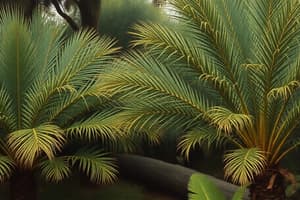Podcast
Questions and Answers
Which of the following features are characteristic of gymnosperms?
Which of the following features are characteristic of gymnosperms?
- Needle-like leaves (correct)
- Presence of vascular tissue (correct)
- Seeds enclosed in fruits
- Production of flowers
What significant reproductive characteristic distinguishes gymnosperms from angiosperms?
What significant reproductive characteristic distinguishes gymnosperms from angiosperms?
- Gymnosperms have a more complex flower structure.
- Gymnosperms can reproduce without water.
- Gymnosperms do not produce seeds.
- Gymnosperms produce seeds that are not enclosed in fruits. (correct)
Which of the following is NOT a primary advantage of gymnosperms?
Which of the following is NOT a primary advantage of gymnosperms?
- Rapid growth and high moisture retention (correct)
- Ability to thrive in poor soil conditions
- Reproductive structures can be transported by wind
- Seasonal shedding of leaves
Which statement accurately reflects the typical habitat of gymnosperms?
Which statement accurately reflects the typical habitat of gymnosperms?
Which process is predominantly used by gymnosperms for their reproduction?
Which process is predominantly used by gymnosperms for their reproduction?
Flashcards
Gymnosperms
Gymnosperms
A group of plants that produce seeds that are not enclosed in a fruit or ovary.
What is the key characteristic of gymnosperms?
What is the key characteristic of gymnosperms?
Gymnosperms have seeds that are not enclosed within a fruit or ovary, instead they are exposed on the surface of cone scales.
What is the role of cones?
What is the role of cones?
Cones are reproductive structures in gymnosperms that bear the naked seeds. They are typically woody or leathery cones.
What is a key difference between gymnosperms and angiosperms?
What is a key difference between gymnosperms and angiosperms?
Signup and view all the flashcards
Name 3 examples of gymnosperms.
Name 3 examples of gymnosperms.
Signup and view all the flashcards
Study Notes
Gymnosperms: General Characteristics
- Gymnosperms are a small group of plants, with 70 genera and 725 species, typically found in temperate and tropical regions.
- They are ancient seed plants, having originated in the Paleozoic era (541 - 252 million years ago), becoming dominant during the Jurassic and Cretaceous periods of the Mesozoic era.
- Many primitive gymnosperms are now extinct, including Cycadofilicales, Bennettitales, and Cordaitales.
- Gymnosperms are characterized as naked seed plants, meaning their ovules (seeds) are not enclosed within an ovary. The word "gymnos" means naked, and "sperma" means seed.
- They are primitive seed plants belonging to the spermatophyta group (Phanerogams).
- Their ovules are borne on the surfaces of megasporophylls.
- Seeds are not enclosed in fruit, unlike angiosperms.
- They are also known as phanerogams without an ovary.
- Living forms are typically evergreen trees or shrubs.
- They frequently exhibit xerophytic traits.
- Their plant body is sporophytic, meaning it's diploid.
- Their bodies are differentiated into roots, stems, and leaves.
- They possess well-developed vascular systems, consisting of xylem and phloem.
Gymnosperm Structure and Function
-
Roots: Many gymnosperms exhibit symbiotic associations with fungi or cyanobacteria. Mycorrhizal associations are common in Pinus. Fungi assist with mineral absorption. Cyanobacteria (e.g., Nostoc and Anabaena) can be associated with coralloid roots of Cycas, aiding in nitrogen fixation.
-
Stems: Gymnosperm stems are typically erect, branched, and woody. However, some, like Cycas, have unbranched stems, while others, like Zamia, have underground stems. Leaf scars are a defining characteristic.
-
Leaves: Gymnosperm leaves are often dimorphic (two types), with foliage leaves (green, simple or compound) and scale leaves (small, deciduous). Leaves typically have a thick cuticle. Stomata are typically sunken. Cycas displays circinate vernation. The mesophyll may be differentiated into palisade and spongy tissue (often not differentiated in Pinus). Leaves lack lateral veins. Lateral translocation of nutrients occurs via transfusion tissues.
-
Xylem: Gymnosperm xylem consists of tracheids and parenchyma cells. Vessels are absent in most gymnosperms but are present in Gnetum. The wood is often characterized as collateral and open.
-
Phloem: The phloem of gymnosperms includes sieve tubes and phloem parenchyma, but lacks companion cells.
-
Wood: The wood can be manoxylic (Cycas) or pycnoxylic (Pinus).
-
Reproductive Structures: Gymnosperms are heterosporous, meaning they produce both microspores (male) and megaspores (female). Megasporangia are found on megasporophylls, and microsporangia on microsporophylls. These structures aggregate into cones (strobili), which are essentially mono-sporangiate. Males cones are short-lived, while females cones usually live for several years. Microsporangia are found on the abaxial side of the microsporophyll and exhibit eusporangiate development. Female cones are formed by aggregated megasporophylls. Megasporophylls can be foliar (Cycas) or cauline (Pinus). Megasporangia are better known as ovules and are orthotropous and unitegmic. Ovular integument layers differentiated. Microspores are released at various stages of the gametophyte. Male gametes are mostly non-motile, except in Cycas and Ginkgo. The archegonia number in the female gametophyte varies (many in Cycas, single in Pinus) and has a single egg and a venter canal cell. Archegonium in Gnetum consists only of ovum. Neck canal cells are absent in Gnetum. Pollination is anemophilous (wind-pollinated). Pollens are deposited in a wet pollen chamber. Fertilization is siphonogamous using the pollen tube for sperm delivery (meroblastic development). Endosperms develop before fertilization, and are haploid. Double fertilization and triple fusion are absent in gymnosperms.
-
Seeds: Gymnosperms have seeds, with a seed coat. Polyembryony (more than one embryo developing within the seed) is prevalent. Seeds can be winged as in Pinus and also have a resting period. Number of cotyledons can vary.
Studying That Suits You
Use AI to generate personalized quizzes and flashcards to suit your learning preferences.




